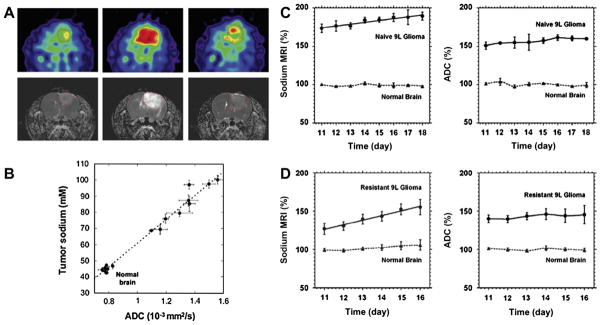Fig. 21.

Examples of sodium MRI and proton DWI studies on tumor and chemotherapeutic response in a rat glioma. (A) Sodium images (top) and proton ADC maps (bottom) of a BCNU-treated 9L rat glioma acquired at days 0, 7, and 23 (left to right). BCNU injection is performed at day 17 after tumor implantation. The central sodium image at day 7 shows a dramatic increase of sodium concentration throughout the entire tumor area. Image at day 23 shows tumor regrowth after tumor shrinking started at day 9 and its maximum regression at day 16. (B) Correlation of tumor sodium concentration and ADC in rat glioma obtained at various points following a single dose of BCNU. (C) Time course after tumor implantation of sodium (left) and ADC (right) variations for a naive type 9L glioma. Sodium and ADC data are given in percent relative to normal contralateral brain. All data are presented as mean ± standard deviation. Sodium concentration steadily increased in the naive tumor at a rate of 2.4% per day while ADC was practically unchanged (1.4% per day). (D) Time course after tumor implantation of sodium (left) and ADC (right) variations for a glioma created from a resistant 9L cell line. Sodium concentration steadily increased in the resistant tumor at a rate of 5.8% per day while ADC was practically unchanged (1.2% per day). Sodium values were corrected for partial volume effects. Figures A and B were reproduced with permission from Ref. [221]. Figures C and D were reproduced with permission from Ref. [224].
